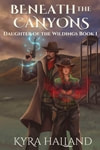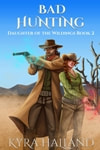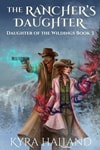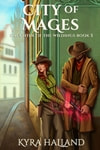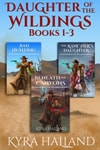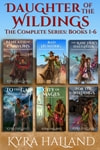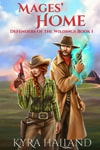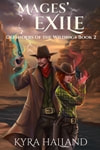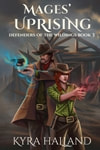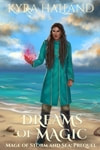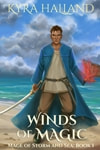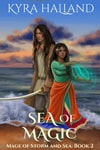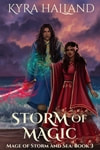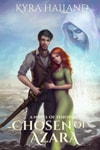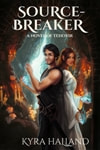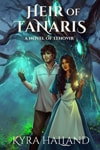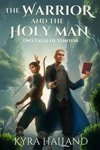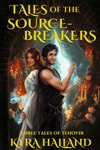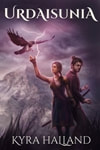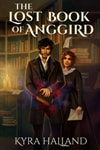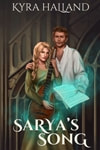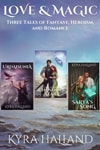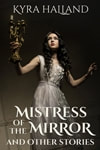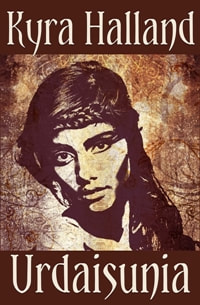 As I mentioned last time, my 5-year publishing anniversary came and went last month. Feb. 11, to be exact, the day I published Urdaisunia. Here it is with its original cover, which I made with a piece of stock art in Photoshop Elements 5. Not too bad, considering the knowledge and resources I had at the time. Since then:
In the last five years, I've met some amazingly kind, helpful, and talented people. (You can see links to some of their websites in the sidebar.) Technically, I suppose authors are in competition with each other, but the indie author community is the most cooperative and supportive competition I've ever seen, with so many people willing to share resources and tips, band together in marketing, and help each other along. Sales-wise, I'm not where I hoped I would be at this point. But I've been correcting some things that might have been holding me back, and making new plans for moving forward. Some things I've learned in the last 5 years:
What lies ahead?
0 Comments
 For the last six months, I've been doing an experiment with having some books exclusive on Amazon, in the Select program for indie authors. The perks of going exclusively with Amazon are that you can have your choice between running a "Countdown" sale or free giveaway days on your book, and also your book is put into the Kindle Unlimited subscription program. The idea behind these is getting more exposure for your work. I found the results of the experiment, for me, underwhelming. I did have some successful free giveaways, getting copies of those two books into several hundred readers' hands. But the long-term benefits are uncertain, and the days when a free giveaway on Amazon would give a long-lasting rankings and visibility boost seem to be long gone. As for Kindle Unlimited, some authors have seen their incomes soar with the program, others have seen drastic drops. The deal with Kindle Unlimited, as far as how authors get paid, is that an equal share is paid out of a monthly pool of money for each borrow, with a short story that would normally cost 99 cents to buy and a 500,000 word epic priced at $9.99 getting the same amount. When I put those two books into Kindle Unlimited, the share was around $2 per borrow. Which wasn't a whole lot less than I would get on a sale of those books, priced at $2.99 and $3.99. However, within a few months, the per-borrow share dropped drastically, to under $1.40. This meant that on borrows of my $3.99 book, I was making about half of what I would make on a sale. That's a pretty big reduction, unless you're getting tons of borrows (and exposure), which this book wasn't. So I came to the decision that the benefits of being in Kindle Unlimited (and the corresponding drop in payment) weren't worth giving up the wider exposure of being on other sales platforms. The upshot of all this is that The Warrior and the Holy Man, which came out of Select a few days ago, is now available at iTunes, Kobo, Smashwords, DriveThruFiction, and OmniLit, and it'll be coming soon to Barnes & Noble (it's been submitted; just waiting for the people there to do whatever it is they do to make it go live). Beneath the Canyons finishes its 90-day term in Select early next week, and will be going wide as well. The release of Bad Hunting has been delayed because I lost about a month of work time between the run-up to Thanksgiving and the start of the new year, but it works out because it should be coming out a couple weeks after Beneath the Canyons goes wide and will be available on all my current sales channels, hopefully giving both books a nice visibility boost. I'm also looking into adding some new channels, including Google Play (tricky because they do a lot of discounting, which Amazon then price-matches, even to the point of making a book free when you don't want it to be free), and setting up direct sales from my site. Also tricky because of the wild and wacky world of sales taxes and VAT, but there are some shopping cart sites I'm looking into that handle the tax stuff. Right now, getting Bad Hunting ready for release and getting back on track on my writing schedule is the first priority, but I hope to be able to get these expanded sales channels set up before too long. Update: The Warrior and the Holy Man is now available on Barnes & Noble. The cover image, however, is not. Hopefully they'll fix that soon; B&N tends to be kind of laggy with updates. Updated Update: The awesome cover of The Warrior and the Holy Man is now showing on B&N. Yay! I don't usually blog about other blog posts, especially not posts directed more at writers than at readers, but this is too good to pass up. Right now, Amazon, which really opened up the possibilities for independent authors with its invention of the Kindle (the first really usable e-reader) and Kindle Direct Publishing (Smashwords also gets credit for starting the independent author revolution, but it was Amazon that brought it mainstream) is involved in difficult negotiations with one of the Big 5 publishers (Hachette). The news media (which in large part is owned by the same giant international comglomerates that own the Big 5 publishers) has been in an anti-Amazon frenzy, spouting out ridiculous claims about how Amazon means the end of literature and ideas and civilization and life the universe and EVERYTHING!!! Passive Guy is an IP (intellectual property) and contracts lawyer with a special interest in independent writing and publishing and in the disruptive technology and business practices that make this revolution possible. His blog is a must-read for independent authors. Here is part of his response to the frenzy: As independent authors arise, empowered by Amazon’s democratic commons of ideas, PG says we’re looking at a renaissance of American literature, an upheaval that is shoving the suits out and putting authors back in charge of the art they create. You can read the whole thing, along with quotes from the article that inspired this response, here: http://www.thepassivevoice.com/05/2014/how-the-amazon-hachette-fight-could-shape-the-future-of-ideas/ For readers, the independent author revolution means more books, less expensive books, a wider variety of books - not just what the sales departments at the publishing companies decide they can market, access to previously out-of-print books whose authors have gotten their rights back (often at great time, expense, and stress), continuation of series that were cancelled by publishers, easier and more convenient access to books in a variety of formats, and closer interaction with authors. Big publishing does not see readers as their customers; their customers are the book distributors and the big chain bookstores. The independent author revolution is good for readers, good for authors, good for everyone except those with a vested interest in preserving the old, bloated, exclusionary, wasteful way of doing things.
Last week I had the opportunity to speak to three wonderful artists who I found on deviantArt.com about commissioning cover art for Daughter of the Wildings. I was very pleasantly surprised with what I was able to afford, with the end result being that not only am I able to get custom cover art for the Daughter of the Wildings series, I can also get a better cover than the one I made myself for Chosen of Azara! I'm not going to go into which artist/s I ended up commissioning (that'll be revealed when I post the covers) or why (that's between me and them, except it was a very difficult decision and a lot of it came down to the looks I wanted for the different projects and the needs of my budget) or how much I'm paying (that's confidential), but I will say that based on my interactions with them so far, I would absolutely recommend any of the three to other writers who are looking for cover artists.
Go take a look: me-illuminated Trisste Design by Katt Also, some authors I read have some new stuff out. The fabulous Camille LaGuire, whose Mick and Casey westerns I really enjoy, is posting a new serial, The Case of the Misplaced Baronness. This one is set in her roughly "silent-movie era" alternate universe and features the indomitable Lady Pauline Anne Marie Tritt-Woolsey Beethingham Smythe, Baroness of Beethingham, aka "Plink." There's something of a Jeeves-and-Woosterish vibe to this, so if you're a Jeeves and Wooster fan (which I am), you'll enjoy this. And Forged in Blood, Part 1, the first part of Book 6 of the Emperor's Edge series by Lindsay Buroker is out. I've really been enjoying this series, and could hardly wait for this book (and can hardly wait for part 2, due out later this summer). Each book is partly in the point of view of a different member of the Emperor's Edge team, and in this last book (or pair of books) we finally get inside the head of Sicarius, the inscrutable yet sexy assassin. And it's a very interesting place to be, indeed. I'm an incurable end-peeker (it's harder to peek at the end with e-books, which I don't know if that's a good thing or a bad thing, but I still manage it if I really can't stand the suspense) and it looks like this one ends with a doozy of a cliffhanger. Just makes the anticipation of the last book all the more sweet! I've also enjoyed the Encrypted/Decrypted duology set in the same world as the Emperor's Edge books. Finally, I want to mention The Norothian Cycle, by M. Edward McNally, yet another amazing independent author. I read the first book, The Sable City, not long ago, and went through it like a box of chocolates. Highly recommended, and I can't wait to read the rest of the series - after I finish Forged in Blood 1 and some Read and Review books for my Goodreads group. Since I started exploring books by independent writers a little more than a year and a half ago (about the time I was considering taking the leap into self-publishing myself), my to-read list, as evidenced by the number of samples on my Kindle, has been growing at an alarming rate. So many fresh voices and exciting books, so little time! One more thing: Here's a shout-out to this week's Paranormal, Fantasy, Dystopia, and Romance Writers and Reviewers group featured author, Donna Hawk! I will be hosting Donna next week as part of her blog tour with Saskia Book Tours, and I'm looking forward to it very much. According to my online banking stuff, my first payout from Amazon, for February sales, is pending. It isn't a lot - we're talking a large (not extra-large) pizza with pepperoni, green peppers, and extra cheese. Maybe black olives. (Although everything I make for the time being is going straight into the cover art fund for the Daughter of the Wildings series, not for pizza.) But it's money that I earned with my writing! Which is seriously cool. It's something that for a long time I thought would never happen. I knew that conventional publishing just wasn't something I wanted to deal with, so I figured I would just never be a professional writer. But now, thanks to Amazon and Kindle and ebooks and print-on-demand and serious (not vanity) self-publishing, I am a pro :-D
I won't be getting another payout for a few months, at least - you have to accumulate a minimum amount in your account both at Amazon and at Smashwords. But that's ok. I know I'm just a little baby self-pubbing author just starting out, and I'm in it for the long term, with a two-year starter plan. But I'm still getting a real kick out of this first payday :-D Camp NaNo report, Day 23: My word counter was being wonky, and I'm taking my total from the Camp NaNo Official Word Counter today, so I'm not sure exactly how many words I wrote yesterday and today. But right now I'm at 23,347/30,000 words. Finally, here's a shoutout to this week's featured author at the Paranormal, Fantasy, Dystopia, and Romance Writers and Reviewers group, Jennifer Howard! Yesterday at The Passive Voice blog, Passive Guy posted a question from a reader who wants to start writing and self-publishing but is overwhelmed by all the information and has no idea where to start or how to go about this. Passive Guy invited commenters to leave their own tips and advice, and here's what I posted. Since I've toyed with the idea of doing a post on the very same subject, I decided to recycle this very fine (if I do say so myself :D) run-down on how to go about becoming an independent author.
* * * I just took the leap in February, and even though I’m still just a little baby self-publisher, I love it and feel confident that this is something that will give me a lot of satisfaction in life. Here’s my list: 1. Write a book. Write what you love, what makes you happy, what you feel driven to write. Don’t worry about writing what will sell, because no one knows that. Also, if you want to make a career of this, you can’t do it with just one book, so be working on ideas for more books. 2. Make the book as good as you can get it. Work on your own revising/editing skills. (Many resources online.) Have some acquaintances who are avid readers read it, or join a critique group (can also be found online). If you have the money, or can arrange a barter or something, find a *good* professional editor. Do what you have to do to make the book as error-free as possible. 3. If you’re broke, have some html know-how or don’t mind learning, and don’t mind doing things yourself, get a guide on how to do the ebook formatting yourself. You can find suggestions on Lindsay Buroker’s and David Gaughran’s blogs. [Specifically, The eBook Design and Development Guide by Paul Salvette and Guido Henckel's blog post series Take Pride In Your eBook Formatting] If you aren’t quite so broke, or don’t want to do it yourself, research ebook formatters. There are a number of them, many with reasonable rates. You can find links on the Kindle boards. 4. For a low-cost cover, license some stock art from a site like Dreamstime, and learn how to do the lettering in an image-editing program. See The Book Designer for good and less-good examples. If you can spend a little more, use a cover designer. You can also find links to this on the Kindle boards. 5. Set up your accounts at the different outlets – Amazon, Smashwords, Barnes & Noble, Kobo are the big ones (Apple too, but you have to have a Mac computer to go to them directly). Check out their individual submission/upload requirements, and follow these carefully. I go direct through Amazon, and use Smashwords for all the others, just to keep it simple. 6. Be VERY VERY CAREFUL ***NOT*** to pay for expensive packages containing services you don’t need or could do yourself. You should be able to pick and choose what services you want/need on an individual basis without getting locked in to a bunch of stuff you don’t need. Also be careful if any service you want to use asks you to sign agreements involving percentages or copyright or exclusivity (KDP Select asks you to make books you enroll in that program exclusive for 90 days, which is as far as any author should be willing to go exclusive, and not everyone even feels comfortable with that). In short, be careful not to get ripped off or trapped in a bad deal. *I did the complete do-it-yourself route, and published my first book for under $100, including $35 to register the copyright in the U.S., expanded distribution fee and proof copy from CreateSpace, licensed stock art, and small gifts for my test readers. 7. Once your book is up for sale, be patient – it will not take off overnight, or even over a few months – and get going on the next book. Might not work for everyone, but that’s how I’m doing it. * * * There's lots of other good advice in the post at The Passive Voice, so go check it out if publishing your writing is something you're thinking of doing. After three days, I've got 3,173 words written on the Tale of Haveshi Yellowcrow, the prequel to the other story I wrote and also based on an old abandoned idea. A few more days should finish it.
For a long time, I never thought of myself as much of a short-story writer. I had maybe a handful of short stories to go with the fifteen or so novellas and novels I'd written. I just figured that short stories weren't a form that I naturally thought in, or that I was comfortable with. But now, in about three weeks or so, I'll have written five short stories, two of them from ideas I abandoned a long time ago because I wasn't sure how to spin them out into novel-length. Which just goes to show a few things: 1. Don't define yourself by what you think you can or can't do, or what you think you're naturally suited for. You just might surprise yourself, especially if you try. 2. In the new world of publishing (as Dean Wesley Smith calls it), the length of what we write doesn't have to be defined by the needs of the publishing industry. The size of an ebook isn't subject to the same cost-effectiveness considerations that paper books are (the bigger the book, the more expensive it is to print and the more space it takes up, while with a book that's too small, readers aren't willing to pay enough to cover the production expenses), and print-on-demand allows for printing one or two at a time of odd lengths of books (though there are limits to how short and maybe how long POD books can be, as a practical matter). Ideas that once seemed impossible to write to a marketable length can now be dug up from the depths of the hard drive or the file cabinet, dusted off, and given life in the length that's right for them. So instead of calling myself a short-story writer or a novel writer, I'm a writer of my ideas, and I write them as short or as long as they need to be. In other news, if you're on Goodreads, come say howdy at my Goodreads author profile. Pre-camp challenge, days -11 and -10. 655 words yesterday, and 1161 words today. Evil conspiracies, a fight, and some serious smooching. :D Why I love writing.
This project might not even get to novella length; it might end up in the neighborhood of very long short story. But this story has been waiting a long time to get told, so I don't think it minds how long or short it is. And there are no length requirements in self-publishing as there are in conventional publishing. Stories can be as short or long as they need to be. An awkward length no longer needs to be a reason for a story to not get written and published, and stories no longer need to be cut down or padded out to meet some arbitrary length guideline. This is a good thing. I knew that getting Urdaisunia formatted and ready for release would be a learning curve. It ended up taking two weeks. But I've learned a few things that will hopefully cut that time down to two days with the next time. Other things, however, remain a mystery.
What I've learned: 1. Command line programs are not my friend. This was what brought me down to crashing defeat in my attempt to completely build an e-book by hand. The very last step is to compress all the different files into a zip file, using a command line zip program because there's one tiny little line of code in its own file that has to go in first and end up at the very top of the zipped file. I followed the instructions exactly, but I just couldn't get that bugger to go in right. I'd run the program, compress my files, run it through the epub validator, and keep coming back with just that one little error. And that one error, that one little 20-byte file, made the ebook unusable. Otherwise it was perfect. *sigh* So I backed up and used the very beautifully-written html and css that I came out of the process with, and learned my next lesson: 2. CSS is my friend, and I can do it. I'd been trying to learn CSS for years and could never quite grasp it, but for some reason the way it's laid out in The eBook Design and Development Guide by Paul Salvette clicked for me. Following the instructions in the guide (and applying the principles to adjust a few things, like my smallcaps, that weren't working right) I ended up with html/CSS files that converted beautifully when I did find conversion methods that worked for me. I'm proud of the formatting in my ebooks, and I hope it leads to a more pleasant reading experience for the readers. Even if the novel isn't great, at least the formatting is wonderful. 3. Also from the eBook Design and Development Guide: Regular expressions are awesome. These are things you can do in a text editor like Notepad++ to do fiddly tedious little things like strip extra blank lines and spaces from a file, wrap the correct html tags around paragraphs or sentences, and cool stuff like that. 4. The CreateSpace Word templates are crazy-making, The formatted one came with weird sections and headers that didn't fit with my novel and that I couldn't figure out how to get rid of. The un-formatted one ate my dropcaps. Finally (after an equally frustrating foray into LibreOffice [see below]), I just set up my own pages using the margin guidelines on CreateSpace, and that worked fine. 5. LibreOffice has many advantages over Word, but its developers hate page numbers. Setting up different page numbers for different sections and getting the right numbers in the right place is much easier in Word. (Or maybe that's because Word's instructions are better-written.) (Note that I'm using Word 2003. Can't speak for later versions.) 6. Typing out small caps for each different version is a pain. Do it once on the source file before doing anything else. 7. Smashwords' Meatgrinder converter actually does a really nice job of converting your .doc into various ebook formats if you follow the Style Guide exactly. I'd heard lots of complaints about the Smashwords conversions, but I'm very pleased with how mine turned out. And some things that may remain mysteries forever: 1. Why did Sigil make my epub come out with a humongozoidal cover image? Seriously. I looked in the previewers, and got a friend to look at it on her Kobo, and you could only see like the top left quarter of the image. Running the conversion through Calibre resulted in a correctly-sized cover image. 2. Why do the makers of LibreOffice hate page numbers? And who writes their instructions? Seriously, that isn't something that should be so hard. So there's two weeks' worth of lessons that should reduce the formatting, conversion, and publishing time on my next book to two days. |
AuthorI am Kyra Halland, author of tales of fantasy, heroism, and romance. Sign up for my email list
My Books
More Books
Click on the covers for more information
Categories
All
Archives
April 2024
Kyra Halland: Welcome to My Worlds is a participant in the Amazon Services LLC Associates Program, an affiliate advertising program designed to provide a means for sites to earn advertising fees by advertising and linking to amazon.com.
Other links on this site may also lead to products for which the owner may receive compensation. This website uses marketing and tracking technologies. Opting out of this will opt you out of all cookies, except for those needed to run the website. Note that some products may not work as well without tracking cookies. Opt Out of Cookies |
 RSS Feed
RSS Feed
